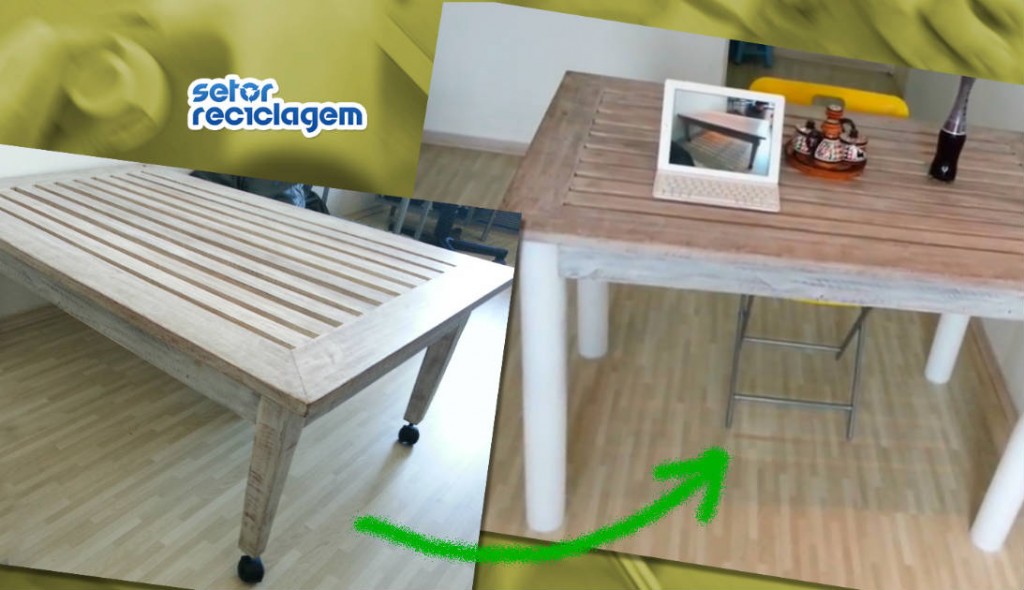Anúncios
Creativity often arises from necessity. Turning a coffee table into a dining table is a perfect example of how to solve a problem in an innovative and cost-effective way. This approach not only saves money, but also promotes recycling and reuse of materials.

From Coffee Table to Dining Table
When you move from a large house to a smaller apartment, it can be challenging to find space for all of your furniture. In this scenario, a four-foot coffee table needed to be transformed into a dining table. The solution was to adapt the existing table instead of buying a new one.
The project began with the need to adjust the height of the table. The decision was made to use plastic tubes, commonly used in signage, to create new legs. This choice was economical and sustainable, as it allowed for the reuse of materials that could otherwise be discarded.
Necessary Materials
To perform the transformation, you will need:
- Existing coffee table
- Plastic tubes (used in signage)
- Basic tools (saw, glue, etc.)
The process is simple and can be completed in just two hours, at no additional cost. Using plastic pipes is an excellent way to reuse materials, reducing environmental impact and promoting sustainability.
Steps to Transformation
- Preparation of Plastic Pipes: Measure and cut the plastic tubes to the desired height. These tubes are lightweight but strong enough to support the weight.
- Fixing the New Feet: Use basic tools to fix the plastic tubes to the table base. Make sure they are securely fixed and level to ensure stability.
- Finish: Adjust the table as needed, including leveling and painting, to match the style of your apartment.
Benefits of Recycling
Turning a coffee table into a dining table is a great way to practice recycling. In addition to avoiding waste, the project demonstrates how creativity can generate functional and sustainable solutions. Recycling contributes to environmental preservation by reducing the need for new resources and reducing the amount of waste.
Examples of Other Creative Transformations
In addition to tables, other furniture items can be reinvented with a little imagination and skill. Consider projects like reupholstering old chairs or creating bookshelves from recycled materials. Not only are these transformations practical, they also help reduce environmental impact and save money.
The Impact of Recycling on Everyday Life
Adopting recycling and reusing practices not only helps save money, but it also plays a crucial role in protecting the environment. In the case of transforming a coffee table into a dining table, reusing materials such as plastic pipes demonstrates how it is possible to reduce waste and minimize environmental impact.
Choosing to use plastic pipes instead of buying new table legs is an example of how recyclable materials can be used creatively. In addition to saving money, you are helping to reduce the demand for new resources and reducing the amount of waste that ends up in landfills. The practice of recycling and reusing can be applied to many aspects of everyday life, from DIY projects to small home improvements.
Additional Benefits of Furniture Recycling
Upcycling furniture offers additional benefits beyond saving money and protecting the environment. Turning old furniture into new pieces can give new life to items that would otherwise be discarded. Not only does this preserve the history and sentimental value of old pieces, it also allows you to customize and adapt the furniture to your current style and needs.
Sustainability and Creativity
Integrating sustainability into your lifestyle can be a rewarding and creative process. By finding innovative ways to reuse materials, you are not only contributing to environmental preservation, but also encouraging creativity and invention. Upcycling projects, such as transforming a coffee table into a dining table, are a great example of how necessity and creativity can come together to create practical and sustainable solutions.
Tips for New Recycling Projects
If you’re interested in starting new recycling projects, consider exploring different materials and techniques. From reusing wood to create custom furniture to transforming everyday objects into decorative pieces, the possibilities are endless. Additionally, participating in online communities or workshops about recycling can provide new ideas and techniques for your future projects. The continued practice of recycling and reusing not only enriches your life with new skills and knowledge, but also makes a positive impact on the environment we live in.
Learn how to make other arts by recycling, Click here.
Check out interesting facts about recycling clicking here.




